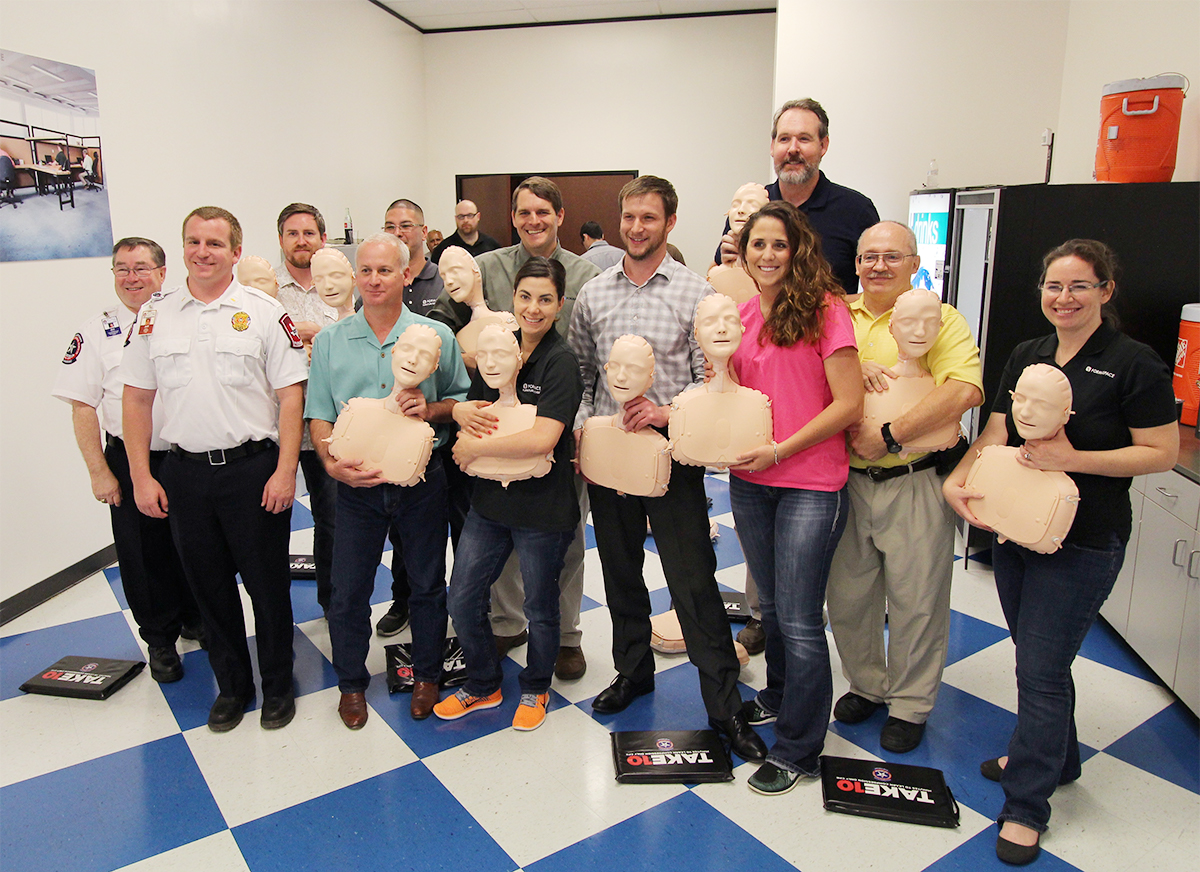In a world where business owners, HR directors, and office managers are competing with other businesses to attract a talented workforce, providing your employees with enhanced workplace wellness benefits can give you an advantage over the competition by improving your recruiting efforts while increasing the productivity, efficiency and satisfaction of your existing employees at the same time.
Designing an effective, competitive employee benefits package is more complicated than ever.
For many companies, providing coverage for employee healthcare is taking an ever bigger slice of the benefits pie as healthcare costs continue to rise for treating the top health threats facing Americans — heart disease, cancer, unintentional injuries, chronic lower respiratory disease, stroke and Alzheimer’s disease.
Prevention of these expensive conditions in the first place can help drive down healthcare costs significantly. For example, there is conclusive medical evidence that controlling one’s body weight can help prevent type II diabetes, which in turn greatly reduces the risk of cardiovascular health problems — including heart attack and stroke. Smoking cessation programs also reduce the risk of heart attack and stroke — as well as lowering the chances of developing lung cancer.
Reducing these major causes of mortality – e.g. heart disease, stroke, and cancer – through wellness prevention programs can really start to bend the healthcare cost curve downwards. To accelerate this change, healthcare payers (e.g. private insurers and government agencies) are beginning to change reimbursement programs for healthcare providers (e.g. hospitals and doctors) away from a traditional fee-for-service reimbursement model toward compensation based on successful patient outcomes.
Employers are doing their part to drive down healthcare costs as well. According to the Society for Human Resource Management (SHRM) 2015 Employee Benefits Report, providing robust wellness benefits for employees has gone fully mainstream.
Let’s take a look at some of the top trends for promoting wellness in the workplace.
Trend 1: Wellness Benefits becoming part of Traditional Health Care
According to SHRM, more than 80% of employers provide traditional employee health care coverage, including dental, prescription drugs, mental health, vision, and even chiropractic coverage. A minority of employers also provide coverage for acupuncture, laser vision correction, elective procedures and alternative medicine.
More than half of the employers surveyed offer wellness resources, including seasonal flu vaccinations and 24-hour nurse lines.
A minority of businesses offer their employees wellness health screening programs (including programs targeting chronic health conditions), paid sick leave, health fairs, and on-site sick rooms.

We’ve written before about how some medical experts have coined the phrase “sitting is the new smoking.” According to the SHRM survey, one-quarter of employers reports that they now pay for their employees to acquire and use a Sit-to-Stand desk. (If you need to learn more about our line of Sit-to-Stand desks, check out this article which shows how they can help prevent lower back pain compared to traditional desks.)
Less than 10% of surveyed employers are providing coverage for experimental drug treatments. However, we feel that genomic personalized medicine is a trend that will become more prevalent as genetic tests for diseases – like cancer – become more common.
How individual employees pay for their medical coverage varies quite a bit. Over half of the employers provide flexible spending accounts, while a lower percentage offer health savings accounts, which allow employees to set aside pretax income to pay for medical expenses such as co-pays or other non-covered items.
Trend 2: Personalized Coaching and Fitness Programs to Encourage Healthy Lifestyle Changes
Nearly half of the employers in the SHRM survey report that they offer health and lifestyle coaching.
About one third offer a subsidy or partial reimbursement for attending a fitness center, and another 21% provide a fitness center on site for their employees to use.
Some employers are able to provide paid hours for their employees to participate in fitness programs, ranging from self-defense training to yoga classes (for improved posture and flexibility as well as stress management) to on-site Zumba sessions (high-intensity aerobic workouts).
Trend 3: Incentives Can Play a Big Role in Encouraging Healthy Lifestyle Changes
In order to drive down healthcare costs, employers have turned to incentives to encourage their workers to participate in wellness programs.
40% reported they are offering rewards or bonuses for successfully completing health and wellness programs. A minority of employers are also providing discounts on health care premiums when employees get an annual health risk assessment or participate in wellness programs.
Many employers offer smoking cessation with healthcare premium discounts for those employees who participate.
Some companies are also providing fitness bands or activity trackers so that employees can monitor their physical activity throughout the day; often these are combined with company organized fitness competitions and challenges that offer prizes and/or bragging rights to encourage participation.
About a third of employers offer a weight loss program, and some also offer discounts on healthcare premiums for participation. Weight loss surgery is also offered by about one-third of employers according to the survey.
Trend 4: Don’t Overlook the Wellness Benefits of Providing Good Nutrition
The vast majority of employers offer a break-room with a kitchenette for their workers.
More than half offer free coffee, but only a small portion offer subsidized snacks and beverages or full meals at an on-site cafeteria.
About 20% of employers are offering nutritional counseling for their employees, and a small percentage offer an on-site vegetable garden or prepared take-home meals.
From our perspective, nutrition is an area that offers an opportunity for employers to improve the overall health of their workers by organizing and providing healthier choices for lunches, snacks, and drinks.
Trend 5: The Nature of Work is Changing Thanks to Increased Job Flexibility
Thanks to fast Internet connections, more and more employees are able to telecommute from home. Over half of the employers offer a telecommuting option, either on a full-time or part-time basis.
Flex time and job sharing are also becoming more prevalent.
Can this be considered part of a wellness program?
Probably so.
Many employees have unique needs. Providing job flexibility can help employees who might need job flexibility to:
- Reduce stress from a long daily commute to the office and enjoy more time with their family.
- Allow them to be a caregiver for an elderly family member.
- Provide at home childcare to a new born or pre-school child.
- Make a more gradual and healthy transition from full-time work into retirement.
Trend 6: Don’t Overlook Wellness When Employees Travel
As we all know, business travel can wreak havoc on the best-laid plans for sticking to your diet and your exercise program.
While the vast majority of employers pay their workers for meals eaten while on the road, only about 5% report reimbursing employees for gym or health club fees while on business travel.
There’s an opportunity for this number to grow in the coming years.
Another wellness consideration is the unhealthy effect that increasingly narrow airplane seats have on our circulation.
About 20% of employers report that they offer upgrades to first or business class for their employees traveling on long international flights.
Paying for increased room over a long period of time could be an important investment in employee health. There’s an increased risk of deep vein thrombosis (DVT) during long flights where you cannot stretch your legs. DVTs are life-threatening blood clots that typically form in the lower extremities – should one break loose they can cause a heart attack or stroke.
Trend 7: Stress Reduction is Important, Includes Taking Time Off from Work
Europeans workers, who typically enjoy six weeks paid vacation, are shocked to learn that Americans often get no more than two weeks of vacation annually.
Worse, studies indicate many American workers often choose not to use all of their available vacation days – either because they think they’re too busy or too indispensable on the job, or they want to convert the paid vacation days into additional income.
Nearly 100% of the surveyed companies in the SHRM report offered paid holidays. Most offer either a vacation plan or some form of paid time off plan as well.
There are reports that some companies even offer an unlimited amount of vacation time to their employees; yet, due to employees’ concerns about their role in the company (or job security), the amount of vacation time actually used turns out to be less than those workers who have a traditional vacation plan.
Perhaps employers should consider making vacation time mandatory!
The SHRM report also revealed a few other stress reduction benefits that fall under the wellness category: Just over 10% of employers offer on-site massage therapy services and about 5% have on-site stress reduction programs.
A small percentage of employers offer benefits related to employee pets. Pets, of course, can be a major source of stress reduction for many people, so we were intrigued to learn that around 10% of employers allow employees to bring their pets to work. A similar percentage offer pet health insurance as well.
Trend 8: Wellness Benefits for Family Health
Parents in the workforce with infants and young children face many challenges, such as finding good child care, obtaining leave for dealing with sick children, providing nursing to infants and so forth.
A minority of employers report benefits designed for young families (or those wanting to start a family), including on-site lactation/mother’s room, fertility treatment, including in-vitro fertilization and egg freezing, ability to bring a child to work during an emergency, paid maternity leave, child care services and adoption assistance.
Some workers find themselves in what is known as the sandwich generation. For these individuals, they have the added responsibility of being a caretaker of their elderly parents or relatives in addition to raising their own children.
In response, a minority of employers are offering elder benefits, such as access to backup eldercare services, eldercare leave, geriatric counseling, and paid eldercare expenses when an employee is on business travel.
Trend 9: Community and Team Building Activities to Promote Health and Welfare
Up until this point, we have presented wellness benefits generally offered to employees on an individual basis. But quite a number of employers are now offering benefits that promote wellness for the entire workforce or the surrounding community.
For example, here at Formaspace, after one of our employee’s lives was saved due to quick action by first responders, we’ve recently begun offering CPR training to all our employees. According to the SHRM survey, about 50% of employers offer CPR or first aid training.

Company-wide activities like hiking, paintball, kayaking, cross-country skiing are all excellent examples of ways to build cohesive teams in the workplace.
About 14% of employers report they sponsor employee sports teams. Don’t overlook the benefit of offering casual sports activities on-site as well. Many companies are now offering amenities like foosball tables, badminton courts or table tennis – you may be surprised how your employees will want to participate in these healthy, team-building activities.
Wellness also extends into the community at large.
About half of employers have established community volunteer programs. A minority will match employee charitable contributions, offer paid time off for volunteering for serving on the board of a community group or professional association.
We’re curious to learn about any unique benefits you offer your employees to encourage wellness at the workplace.
Formaspace Cares about Your Wellbeing at the Office
If you would like to know more about how Formaspace Sit-to-Stand Desks can help you and your employees reduce back pain while working, then contact one of our Design Consultants today.
See original post on Formaspace.com

